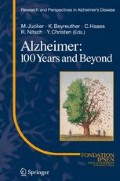Summary
Alzheimer’s disease (AD) is a very common brain pathology of the elderly, with an etiology that is far more complicated than was thought in the 1990s. In particular, the complexity comes from the coexistence of two degenerating processes, tau aggregation and Aβ deposition, that affect polymodal association brain areas, a feature never observed in non-human primates and one that is difficult to model. Genetic studies have shown that AβPP plays a central role in familial and sporadic AD, but the role of tau has been understated for a long time. The first evidence of this came from the demonstration of the concept of pathological tau proteins in AD and their full biochemical characterization as a major triplet (tau 60, 64, 68) plus tau 72. This concept was extended to most neurodegenerative diseases with dementia, since pathological tau proteins present a disease-specific bar code: a major upper doublet for parkinsonian diseases with dementia (PSP, CBD, Guadeloupe), a lower doublet for Pick’s disease, and a single band for myotonic dystrophy. This bar code results from the aggregation of specific tau isoforms and was merged with tau mutations in familial frontotemporal diseases as amore global concept of tauopathy linked to most dementing neurodegenerative disorders.
To apprehend the role of tau in AD, which is 99% sporadic, we have developed a spatio-temporal analysis of tauopathy in many brain areas of hundreds of nondemented and demented patients. This prospective and multidisciplinary study showed us that tauopathy always progresses in the brain along a very precise and invariable pathway, from the entorhinal to the hippocampal formation to polymodal association areas, ending in primary regions and in many subcortical areas. The cognitive impairment follows exactly the progression of the affected brain regions. In strict parallel, neocortical Aβ deposits increase in quantity and heterogeneity, suggesting a direct link between both neurodegenerative processes. Altogether, our molecular studies suggest that AD is a tauopathy fueled by AβPP dysfunction. Restoring AβPP loss of function seems to be the most efficient and pragmatic therapeutic approach.
Access this chapter
Tax calculation will be finalised at checkout
Purchases are for personal use only
Preview
Unable to display preview. Download preview PDF.
Author information
Authors and Affiliations
Editor information
Editors and Affiliations
Rights and permissions
Copyright information
© 2006 Springer-Verlag Berlin Heidelberg
About this chapter
Cite this chapter
Delacourte, A. (2006). The natural and molecular history of Alzheimer’s disease: Tau is part of the story. In: Jucker, M., Beyreuther, K., Haass, C., Nitsch, R.M., Christen, Y. (eds) Alzheimer: 100 Years and Beyond. Research and Perspectives in Alzheimer’s Disease. Springer, Berlin, Heidelberg. https://doi.org/10.1007/978-3-540-37652-1_41
Download citation
DOI: https://doi.org/10.1007/978-3-540-37652-1_41
Publisher Name: Springer, Berlin, Heidelberg
Print ISBN: 978-3-540-37651-4
Online ISBN: 978-3-540-37652-1
eBook Packages: Biomedical and Life SciencesBiomedical and Life Sciences (R0)

